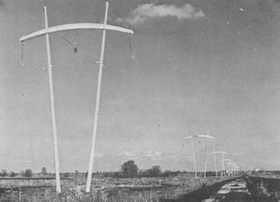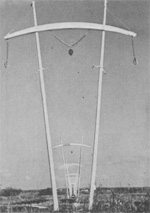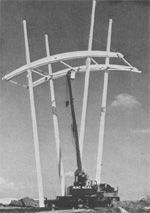Design Unique Power Poles for NAL
As NAL develops, it promises to be the home of many significant architectural features ... both the site and its buildings will reflect something of the spirit and adventure of the esoteric business of discovery that is to be carried on here.
One of the latest architectural innovations with a high degree of visibility, both literally and figuratively, crosses 2.2 miles of the 6,800 acre site. The creations are unique, modern and matching power poles, designed by Robert R. Wilson, NAL's Director, to bring in the electrical power required to service major components of NAL's accelerator system.
The power poles add much to the aesthetic beauty of the Fox River Valley prairie. They promise to stand as one of the many new landmarks to adorn the NAL site, which already includes such scenic centers as the Curia, the Village Barn, the Booster pond and other architectural achievements as well as the "new look" of the re-painted houses in the Village. The new power poles are soft on the eyes and combine function and form with contemporary design. They provide excellent subjects for camera fans.
The power poles are modified "H" structures built of two wooden poles with two curved cross-arms to link the poles. All have been erected and work on the electrical cabling is beginning. Their purpose is to link the power offered from Commonwealth Edison Company's transmission lines, along the eastern boundary of NAL, with the Master Substation at the Main Site.
It is expected that construction of the 345 Kilovolt transmission line will be completed in late 1970. Work on the Master Substation is more than 90 percent complete. The exterior electrical work running to the substation consists of a three-wire overhead transmission system carrying electrical power at 345 Kv, 3-phase, 60Hz, with two static wires, supported on single circuit wooden pole structures.
There are 19 new Wilson-designed pole structures in the main power line linkage system. Each pole is 100 feet in length. The conductors are supported 65 feet above grade level. In addition, there are 20 more feet to the top of each pole with 15 feet below ground level. The NAL power line taps the Commonwealth Edison transmission line, near the northeastern boundary of the 6,800 acre Laboratory site, not far from Roosevelt Road between West Chicago and Geneva. Several months ago, the Commonwealth Edison line was relocated to an easement on the site's boundary.
Each power pole structure will support three conductors with a safety cable attached to the top of its two supports for men assigned to aerial installation and repair work. When each structure is completely installed, it will be anchored to the ground with down guys.
Installation of the new power lines is under the general direction of William Riches, NAL Plant Manager, a resident of Geneva. Ken Sceper, of Woodridge, is the NAL electrical engineer assigned to the project.
Once the power is brought to the master substation via the new poles, it will be transformed from 345 Kilovolts to 13.8 Kilovolts and then distributed about the entire main site through an underground distribution system via plastic conduit encased in concrete, a minimum of 24 inches below grade. Linac, Booster, the Transfer Gallery and the Experimental Areas, of course, will be among the major accelerator system units serviced in such a manner.
In the case of the Main Accelerator, which is four miles in circumference and 1.24 miles in diameter, direct burial cable is utilized for the distribution system. There will be substations adjacent to each of the 29 service buildings around the Main Ring. At the individual substations, the voltage will be reduced from 13.8 Kv to 480/277 volts. This voltage reduction also will be done for each of the other Laboratory components -- Linac, Booster, Beam Transfer, Experimental Facilities.





